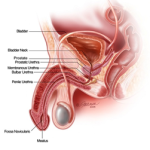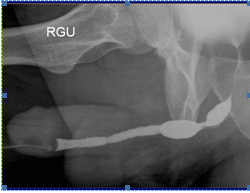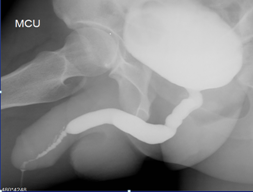What is a urethral stricture?
The urethra is a tube which carries urine from the bladder to outside the body. An abnormal narrowing in the tube is called urethral stricture disease. It is actually a scar in and around the urethra. This results in a narrow, rigid segment which obstructs the flow of urine.
Are there different parts to the normal urethra?
Yes, there are. From the bladder, the urine passes through an opening called the bladder neck into a portion of the urethra surrounded by the prostate gland and this part is called the prostatic urethra. The next portion of the urethra is surrounded by a voluntary sphincter and this part is called membranous urethra. The prostatic urethra and the membranous urethra together are the about 3-4cm length. This leads on to the bulbar and penile urethra. The bulbar urethra is located in the perineum and extends up to the penoscrotal junction. The penile urethra lies in the under the surface of the penis. The exit at the tip of the glans penis is called the meatus. The bulbar urethra and penile urethra are almost equal in length (6-7cm each).
A stricture may occur anywhere from the tip of the penis up to the bulbomembranous junction urethra.
What are the causes of urethral stricture?
Since the stricture is basically a scar, it has to follow some injury to the urethra. The common causes of injury are; road traffic accident, infections in the urethra, damage following instrumentation, and some inflammatory diseases peculiar to the genital skin like BXO (Balanitis Xerotica Obliterans). In several cases, no cause can be identified. Those due to trauma usually have associated fracture of the pelvic bones. The other type of accident is a straddling injury which occurs when falling onto the crossbar of a bicycle or a 2 wheeler and the injury occurs in the region between the two thighs (perineum). The instrumentation that causes urethral stricture can vary from catheterization to endoscopic procedures for ureteric stones or prostate surgeries. In children, it can also occur following reconstructive surgery for birth defects of the urethra or it may be congenital.
Who is at risk for urethral strictures?
The urethra in men is more susceptible to disease or injury, as it is longer than in females.
What are the common symptoms of patients with strictures?
Most Common Symptoms of Urinary Strictures
The common symptoms are a poor urinary stream, straining to pass urine, frequent urination, sense of incomplete emptying of the bladder, burning while passing urine, blood in the urine, urinary tract infection and sometimes inability to pass urine. Sometimes there may be no symptoms and it may be incidentally diagnosed.
How are urethral strictures diagnosed?
After the history and physical examination, basic blood, urine and ultrasound tests, the doctor would ask for a uroflowmetry in which the patient passes urine in a commode like a machine which records flow rates in a graphic manner.
If these tests are abnormal, further imaging tests include 2 types of urethrograms: Retrograde urethrogram (RGU) and Micturating cystourethrogram (MCU). In RGU, contrast (fluid that can be seen on an X-ray) is inserted into the
urethra at the tip of the penis with the help of the catheter and image is captured. It gives invaluable information about the number, position, length, and severity of the stricture(s).
In MCU, the contrast is generally filled with a needle puncture when the bladder is full. Images are taken when passing urine. Both these will help the doctor to study the entire urethra. After these tests, you may experience mild pain, discomfort, burning or bleeding while passing urine. But these will subside within a day.
Rarely urethroscopy is performed to examine the urethra under anesthesia. This will give information about the health of urethral mucosal lining in addition to details of the stricture. If the foreskin cannot be retracted over the glans and there is suspicion of BXO, the doctor will advise circumcision and the foreskin biopsy report will help plan the type of repair.




